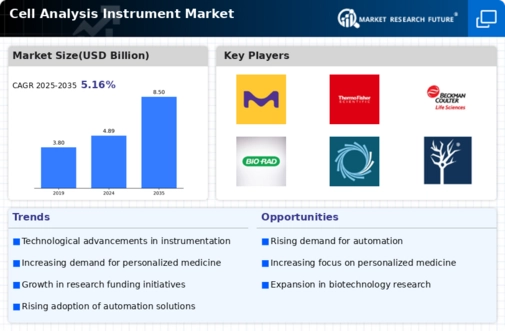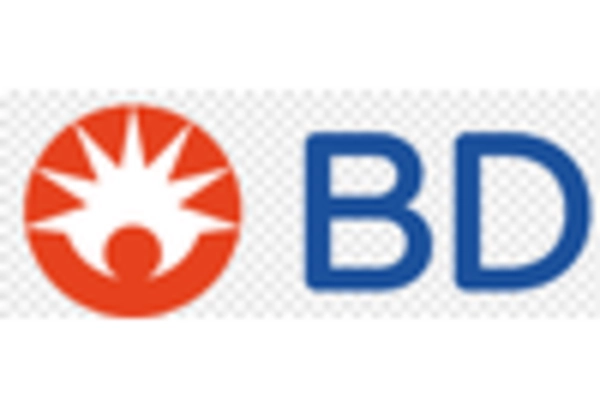Increased Focus on Cancer Research
The Cell Analysis Instrument Market is significantly influenced by the heightened focus on cancer research. With cancer remaining one of the leading causes of mortality worldwide, there is an urgent need for advanced diagnostic and therapeutic tools. The market for cell analysis instruments is expected to expand as researchers seek to understand cancer biology better and develop targeted therapies. Recent statistics indicate that The Cell Analysis Instrument is anticipated to reach over 200 billion USD by 2026, which underscores the potential for growth in the cell analysis segment. This trend suggests that investments in cell analysis technologies will likely increase, as they are essential for advancing cancer research and improving patient outcomes.
Rising Demand for Cell-Based Assays
The Cell Analysis Instrument Market is experiencing a notable increase in demand for cell-based assays, driven by their critical role in drug discovery and development. These assays provide insights into cellular responses, enabling researchers to evaluate the efficacy and safety of new therapeutics. According to recent data, the market for cell-based assays is projected to grow at a compound annual growth rate of approximately 10% over the next few years. This growth is indicative of the broader trend towards more sophisticated and reliable testing methods in the pharmaceutical and biotechnology sectors. As a result, manufacturers of cell analysis instruments are likely to invest in innovative technologies to meet this rising demand, thereby enhancing their market presence and competitiveness.
Emergence of Advanced Imaging Techniques
The Cell Analysis Instrument Market is witnessing a transformation due to the emergence of advanced imaging techniques. Innovations such as high-content screening and live-cell imaging are revolutionizing the way researchers analyze cellular processes. These techniques allow for real-time observation of cellular dynamics, providing invaluable data that traditional methods cannot offer. The integration of artificial intelligence and machine learning into imaging technologies further enhances their capabilities, enabling more accurate and efficient analysis. As these advanced imaging solutions become more accessible, the demand for sophisticated cell analysis instruments is expected to rise, potentially leading to a market growth rate of around 12% in the coming years.
Growing Applications in Regenerative Medicine
The Cell Analysis Instrument Market is increasingly driven by the growing applications in regenerative medicine. As the field of regenerative medicine expands, the need for precise cell analysis becomes paramount. Techniques such as stem cell research and tissue engineering require robust analytical tools to assess cell viability, differentiation, and functionality. The regenerative medicine market is projected to reach approximately 100 billion USD by 2025, indicating a substantial opportunity for cell analysis instrument manufacturers. This growth suggests that companies focusing on developing instruments tailored for regenerative applications may find themselves well-positioned to capitalize on this burgeoning sector.
Regulatory Support for Biopharmaceutical Development
The Cell Analysis Instrument Market is positively impacted by regulatory support for biopharmaceutical development. Governments and regulatory bodies are increasingly recognizing the importance of biopharmaceuticals in addressing unmet medical needs. This support often translates into streamlined approval processes and funding for research initiatives, which in turn drives demand for cell analysis instruments. As biopharmaceutical companies seek to comply with stringent regulatory requirements, the need for reliable and efficient cell analysis tools becomes critical. The biopharmaceutical market is expected to grow significantly, with projections indicating a value of over 400 billion USD by 2025. This trend suggests that the cell analysis instrument sector will likely benefit from the expanding biopharmaceutical landscape.


















Leave a Comment